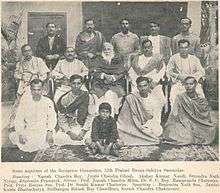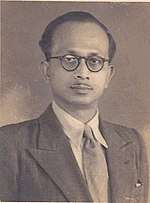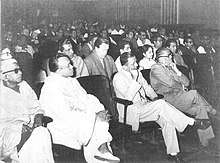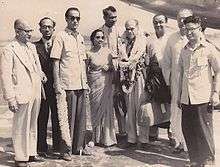Diptendu Pramanick
Diptendu Pramanick (July 18, 1910 – December 15, 1989) was a Bengali film personality from Calcutta. He was the founder secretary of the Eastern India Motion Pictures Association [1] in Calcutta, India - a fraternity of film personnel which is an interface between the entertainment industry of eastern India and the Government. During his multifarious career he came in contact with eminent personalities and saw the evolution of this organization from its initial days to being a regionwide entity.
Diptendu Pramanick | |
|---|---|
 | |
| Born | July 18, 1910 Calcutta |
| Died | December 15, 1989 (aged 79) Kolkata |
| Nationality | Indian |
| Years active | 1931-1976 |
| Home town | Shantipur |
| Children | Subrata Pramanick & Eva Kundu |
| Parent(s) | Swarnabala & Sudhamoy Pramanick |
Early life and education
He was born on 18 July 1910 in Calcutta. He was the eldest son of Sudhamoy Pramanick from Shantipur. He did his early schooling in Calcutta and then at the Raiganj Coronation School, Raiganj where his father practised as a lawyer.
In 1926 he returned to Calcutta and cleared Matriculation followed by the Intermediate examinations in Science in 1928. He then joined the Scottish Church College, Calcutta.
His interactions with many a revolutionary (due to his father's involvement with the Congress and the Satyagraha movement at Raigunj), the explosive air of the times, and the inspiration from a famous alumni (The Oaten Affair - Netaji Subhas Chandra Bose assaulted Prof Oaten due to the latter's derogatory comment on Indians ) [2] probably drove him to antagonize an Indian-loathing teacher at Scottish Church College, and follow Bose's suit.
He later graduated from Asutosh College, and earned a bachelor's degree in science from the University of Calcutta in 1931.
Career
1931 - 1948

.Also seen is Akshay Kumar Nandi
After leaving college, he worked as the Secretary to the then Mayor of Calcutta Sri Santosh Kumar Basu.[3] Out of his literary inclinations, he associated with literary conferences and Bengali literature fora.[4] The 12th Prabasi Banga-Sahitya Sammelan was inaugurated by Rabindranath Tagore in Calcutta, December 1934 (Photo : The Reception Committee was chaired by Ramananda Chatterjee).
On completion of Mr Basu's term as Mayor, he became the Liaison Officer of Civil Defense and in the Publicity Section of the Commercial Museum. In 1942, he moved to the Home Department of the then Bengal Government as Liaison Officer, Civil Defense. The concept of Civil Defence owes its origin to erstwhile ARP Organisation raised and operated during World War II (1939–45) to safeguard the life and property of the civilian population and train the citizens to handle war time crisis.
At this time, Japan had overrun Burma and the threat of bombing was looming large on Calcutta. Eventually Japanese aircraft bombed Budge Budge (south of Calcutta). A Bengali folk rhyme [5] captures this World War II event:
| Sa-re-ga-ma-pa-dha-ni | [Do re me fa so la ti] |
| Bom(b) phelechhe Japani, | the Japanese have dropped a bomb |
| Bomer modhye keute shap | There is a cobra in the bombs |
| British bole bapre-bap. | The British shout, (in awe and fear) |
The bombing led to widespread panic - over a million people fled from the city and there was a huge pressure on civic authorities to control the situation. Indian Civil Defence Department expanded at a rapid pace to counter these threats and planned lighting restrictions, medical platoons, fire-fighting and rescue units.[6] At the end of the war, the department was wound down starting 1947.
Subsequently, he tested his skills of entrepreneurship through a venture (Cine Furnishers Limited) with a couple of friends . It is here that he came in close contact with people of the Bengali film industry of Kolkata.

EIMPA
Enthused with these contacts, he joined an association of producers, distributors and exhibitors of Bengal (Bengal Motion Pictures Association) in 1948 as Secretary [7][8] while Sri B. N. Sircar was the President. Next year he started the BMPA journal[9][10] and was the editor [11][12] for more than two decades.[13][14][15] The Association was working on a rented premises at 125, Dharamtolla Street (now Lenin Sarani) which was moved to 2, Madan Street, Calcutta. The association grew under his leadership and moved into 98E Chowringhee Square (now 98E B.N. Sircar Sarani – EIMPA house - its present location ).
He was the first secretary of the then expanded Eastern India Motion Picture Association (EIMPA) and was instrumental in opening the EIMPA offices in Patna and Guwahati.[16] In this period the uncertainties of war led to severe shortage of raw film stock in the country. A Film Advisory Committee was formed under the Government of India, and was given control of raw film stock distribution.[17] EIMPA played an important role as a trade representative, negotiating materials for the film industry of eastern India and much of Diptendu's efforts were directed for the same. During his tenure he also served as the Secretary of Film Federation of India (1953–1954).[18] In 1956, Diptendu and other stalwarts like Satyajit Ray, Robert Hawkins, Vijaya Mulay and Dasgupta revived the Calcutta Film Society which witnessed the joining of 300 members.[19]

The same team were then the prime movers behind the formation of the Federation of Film Societies of India (FFSI) in 1959 which was presided by Satyajit Ray, with Diptendu as the Jt. Treasurer [20][21][19] during which Indira Gandhi was a member of the FFSI (till 1964).[19]
First International Film Festival of India (IFFI), 1952

The Films Division of the Government of India sponsored and organized the First International Film Festival of India in 1952. BMPA played a pivotal role in organizing the festival in Calcutta. Frank Capra, the famous American director flew in [22] and was overwhelmed by the reception he got at Calcutta after visiting Bombay and Delhi. In his autobiography he wrote
.. Was deluged with garlands ... Bengali people are quite different from the rest of India. They are like the Irish, emotional, sentimental. All riots and revolutions start in Bengal. I can understand it. It took me an hour to leave the airport, what with the crowds and the photographers...
— The name above the title - an Autobiography [23]
This photograph depicts his welcoming at the Dum Dum Airport as in his autobiography, with the who's who of Calcutta Filmdom.
First film seminar, 1955
Sangeet Natak Akademi convened the first film seminar at Delhi and it was inaugurated by Prime Minister Pandit Jawaharlal Nehru.[24] Prominent film personality attended this seminar [25]
 Invitation to meet the President - Dr Rajendra Prasad at his residence |
 Invitation from the Prime Minister, Pandit Nehru to meet at his residence |
Twilight years
In the early 1970s, he was still getting nominated to committees [16][26] - representing the Cinema trade for their infrastructural and legal issues, including the significant 1967-68 and the 1973-74 Parliamentary Estimates Committee.[27][28]
The elaborate reports of the 1968 & 1973 Committees raised issues about institutional finances, cess based state funding of cinema, creating a generation of ‘low-budget’ stars to counter the lopsided economics of a star-heavy industry and censorship reforms. In that sense the report anticipated the birth of a generation of stars from the state-driven FTII in the Naseeruddin Shah and Smita Patil era.[29]
The Pramanick family
| Gobindo Chandra | Radharani | ||||||||||||||||||||||||||||||||||||||||||||||||||||||||||||||||||||||||||
| Sudhamoy Pramanick | Swarnabala | ||||||||||||||||||||||||||||||||||||||||||||||||||||||||||||||||||||||||||
| Diptendu Pramanick | Niyoti | Nabendu | Suprabha | Subhendu | Anita | Sabita | Nikhilendu | Asita ... | |||||||||||||||||||||||||||||||||||||||||||||||||||||||||||||||||||
| Subrata | Gouri | ||||||||||||||||||||||||||||||||||||||||||||||||||||||||||||||||||||||||||
| Sougata Pramanick | Aditi | ||||||||||||||||||||||||||||||||||||||||||||||||||||||||||||||||||||||||||
| Sharmila | Oindrila | ||||||||||||||||||||||||||||||||||||||||||||||||||||||||||||||||||||||||||
Legacy
Children from many underprivileged families of Dahuka, a remote village in Bardhaman district, receive school books from the Diptendu Pramanick Book fund every year, during a ceremony held on the occasion of the Saraswati Puja.[30] The apex body of film distributors and producers (EIMPA) continues to help the industry facing the challenges of corporatisation, censorship, piracy and "multiplexes".[31][32][33]
References
- "EIMPA official website". Archived from the original on 8 January 2015. Retrieved 8 January 2015.
- "Subhas Chandra Bose assaults Oaten, 1916". Archived from the original on 15 April 2010. Retrieved 15 June 2010.
- "Kolkata Mayors : KMC". Archived from the original on 2 April 2015. Retrieved 21 March 2015.
- Ramananda Chatterjee:The Modern Review (Calcutta), vol 57 ; The Modern Review Office, Calcutta (1935), page 141.
- "Bengali folk rhyme". Archived from the original on 20 April 2014. Retrieved 13 August 2014.
- Drucquer, Seth (June 1942). Civil Defence in India. Calcutta: Oxford University Press. ISBN 9781406758962.
- Screen Year Book & Who's who 1956, Express Newspapers Ltd., Mumbai, page 374
- V. Doraiswamy, V.N. Sharma (ed.). Asian Film Directory & Who's who. p. 255. Archived from the original on 2 May 2019. Retrieved 21 September 2016.
- "British Film Institute guide" (PDF). Archived from the original (PDF) on 2 June 2010. Retrieved 17 June 2010.
- Erik Barnouw : Indian Film, Columbia University Press, New York (1963), pages 143, 206, 284.
- Centennial Issue : Newspaper Press Directory, volume 100, Benn Brothers Ltd, London (1951), page 502
- Ayyar, K.P.V. (1956). The Indian Press Year Book. Indian Press Publications. p. 343. Archived from the original on 2 May 2019. Retrieved 17 January 2017.
- The Indian Press Year Book. Indian Press Publication. 1954. p. 304. Archived from the original on 2 May 2019. Retrieved 1 September 2015.
- Newspaper Press Directory, vol 102. Benn Brothers Ltd, London. 1951. p. 625. Archived from the original on 2 May 2019. Retrieved 18 January 2017.
- Sur, Ansu (1999). Bengali film directory. Kolkata: Nandan, West Bengal Film Centre. p. vi,280. Archived from the original on 14 February 2017. Retrieved 7 August 2014.
- "Indian Law". Archived from the original on 26 July 2011. Retrieved 18 June 2010.
- "Archived copy" (PDF). Archived (PDF) from the original on 3 March 2016. Retrieved 14 February 2012.CS1 maint: archived copy as title (link)
- V. Doraiswamy, V.N. Sharma (editors), 1956 : Asian Film Directory & Who's who, Doraiswamy-Mumbai, page 53
- Cherian, VK (2016). India’s Film Society Movement: The Journey and its Impact. Sage Publications India Pvt Ltd. p. 264. Archived from the original on 2 May 2019. Retrieved 25 April 2019.
- http://www.premendra.info/art16.htm accessed at https://web.archive.org/web/20091124180214/http://www.premendra.info/art16.htm on 14 Jan 2012 : published in Chitralipi, Kolkata (May 2006)
- "Film Society Movement in India" (PDF). Archived (PDF) from the original on 1 October 2015. Retrieved 18 August 2016.
- "Capra at Turner Classic Movies website". Archived from the original on 6 June 2010. Retrieved 18 June 2010.
- Frank Capra, The name above the title - an Autobiography, Vintage Books, New York, 1985, page 437
- "Film & TV guild website". Archived from the original on 19 July 2011. Retrieved 20 June 2010.
- "Archived copy". Archived from the original on 13 July 2011. Retrieved 20 June 2010.CS1 maint: archived copy as title (link)
- Report of the Enquiry Committee on Film Censorship. Government of India, Ministry of Information and Broadcasting. 1969. p. 163. Archived from the original on 2 May 2019. Retrieved 18 January 2017.
- Second Report-Estimates Committee (Fourth Lok Sabha) (PDF). Parliament Library: Lok Sabha Secretariat. 1968. Archived (PDF) from the original on 15 May 2019. Retrieved 15 May 2019.
- Estimates Committee (Volume 5, Issues 56-58 ed.). Parliament Library: Lok Sabha Secretariat. 1973. Archived from the original on 2 May 2019. Retrieved 17 January 2017.
- RAJADHYAKSHA, ASHISH (2009). Indian Cinema in the Time of Celluloid From Bollywood to the Emergency (PDF). INDIANA UNIVERSITY PRESS. p. 235. ISBN 978-0-253-22048-6. Archived (PDF) from the original on 18 January 2017. Retrieved 17 January 2017.
- 2010 Annual report of the Dr S. S. De Education Foundation (Regn# S-196221 1999-2000 : W.B.Societies Act 1961), page 5.
- "EIMPA plans Tollywood survival kit, TOI, Jan 3, 2003". Archived from the original on 9 September 2015. Retrieved 22 July 2013.
- "A tryst with money, The Telegraph, June 30, 2013". Archived from the original on 5 October 2013. Retrieved 22 July 2013.
- "EIMPA guidelines required for censorship, TOI, Jul 5, 2014". Archived from the original on 8 July 2014. Retrieved 29 July 2014.
External links
| Wikimedia Commons has media related to Diptendu Pramanick. |